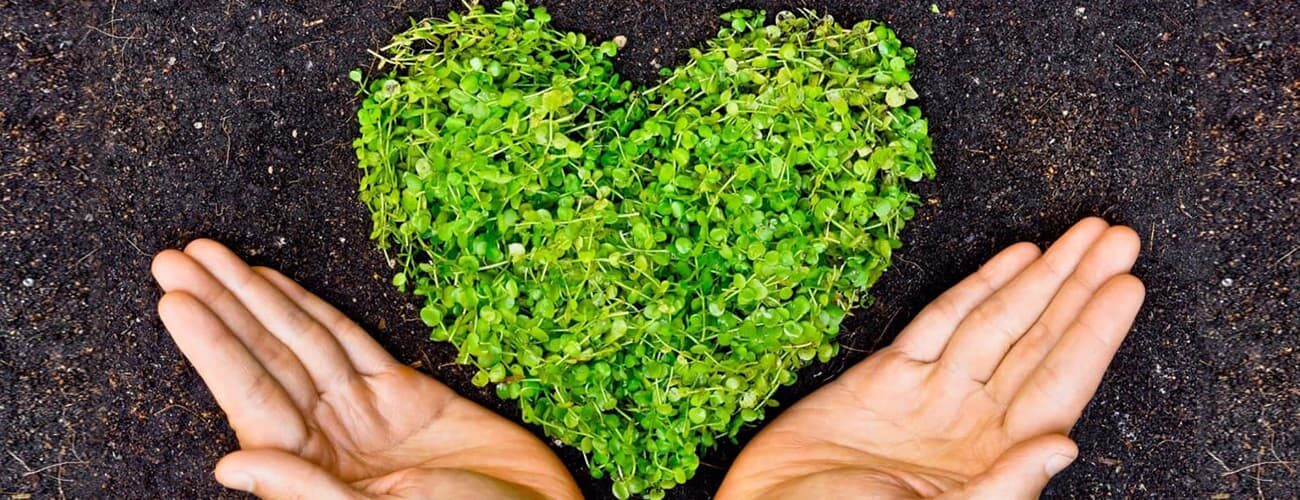The healthier your plants are the less likely they are to succumb to pests or diseases. Healthy plants start with healthy fertile garden soil. Soil is made up of mineral particles (like clay, chalk and sand), water, organic matter, mini-beasts and micro-organisms. It always blows my mind to try and imagine how small many of these organisms are. One teaspoon of soil can contain more micro-organisms than there are people on the planet! These micro-organisms and creatures, like worms, are vital. They break down the organic matter into compounds that plants can use to grow well and thrive. Soil also needs to be loose enough for roots to push their way through, for water to drain away and for air to circulate. Micro-organisms and mini-beasts create tunnels and spaces in the soil that allow these things to happen.


This article aims to give you advice on how to improve your soil whether you garden on clay, chalk, silt or sand so that you can grow healthier more productive plants.
1. Test your Soil
The simplest tests will merely tell you the pH of your soil, but this is very useful information. Many plants including rhododendrons and camellias, hate alkaline soil. Acid loving plants cannot access nutrients in alkaline soil and will grow poorly or die. Other plants like ceanothus and lilacs, prefer alkaline soil. Choose the right plant for your conditions and they will thrive.
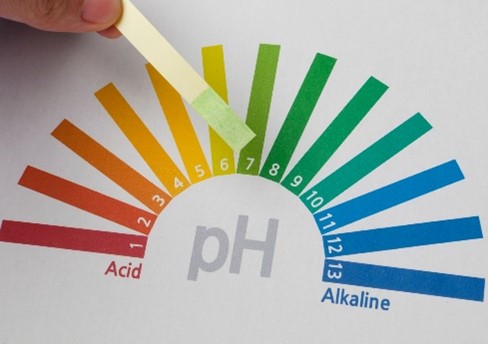
More in-depth testing will help to determine what other nutrients are lacking in your soil. These tests however, are expensive. If you know what pH you soil is, and you follow the steps outlined in this article, you will be building the fertility and health of your soil. This is an ongoing process that will reward you with vigorous, thriving flower beds and abundant harvests. It is akin to people eating a range of healthy foods to ensure they are getting a range of vitamins.
2. Reduce Compaction
Soil becomes compact over time by being trodden on and by the actions of weather such as drought and heavy rain. Clay and silty soils are the most susceptible. Compact soil is very hard and difficult to dig. It does not drain easily and often forms a hard pan that rain runs off, rather than soaking into. It holds very little air and is often devoid of worms and beneficial creatures. Plants will not root easily into compacted soil, nor be able to access nutrients fully, leading to them starving and dehydrating.
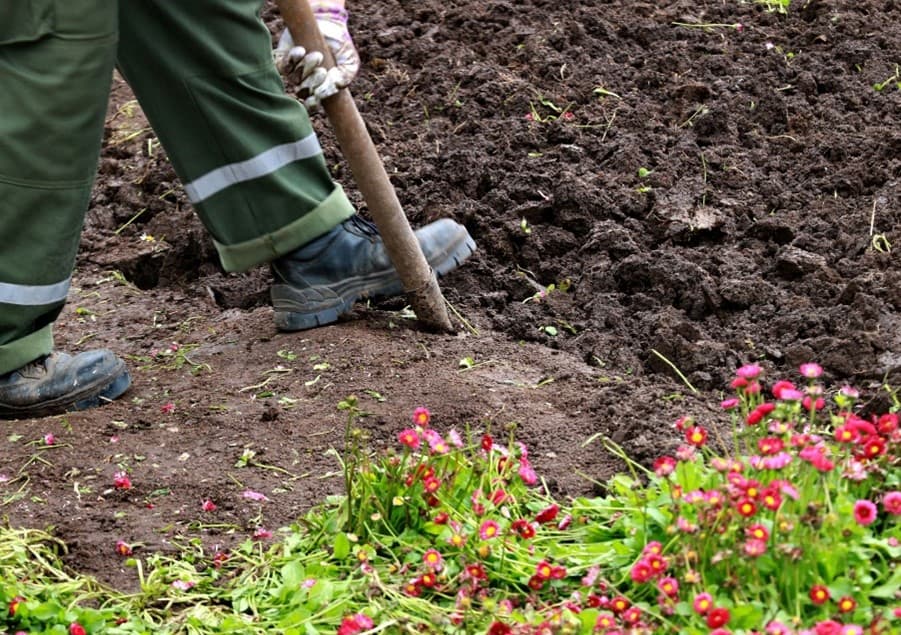
Digging is very good exercise, but it generally uses muscles many of us don’t normally notice until we sit down later. Prolonged periods of digging can cause back pain. It is recommended to do some gentle stretches before and after digging. For heavy soils, like clay, dig in the autumn and leave clumps exposed to the air for frost to break down. If you have heavy clay add a bucketful of horticultural grit for every square metre. This which helps the soil to drain better. Never dig soil when it is waterlogged or frozen, it is very difficult, demoralising and can make the soil structure worse. For lighter chalky and sandy soils wait until late winter or early spring. As you dig over your soil, mix in plenty of organic matter as you go. Use at least one 50L bag of compost for every two square metres.
Once you have dug over your compacted soil try not to walk on it again. If your border or bed is too wide to reach the middle or back without walking on it, lay a plank on the soil to spread your weight or place permanent stepping stones at intervals. If you follow these guidelines you may never need to dig your soil again except to put in new plants or harvest root vegetables.
3. Mulch with Organic Matter
Organic matter is the decomposing products of anything that was alive, for example: plant prunings, vegetable peelings, shredded leaves, grass clippings and animal manure. Organic matter feeds the soil and its micro-organisms releasing the nutrients for plants to absorb through their roots. It also acts like a sponge, holding on to significant amounts of moisture which plants can access in dry weather. It prevents particles of clay and silt from sticking together. This results in looser soil, allowing air and water to reach the roots. For very free draining sandy or chalky soils it helps prevent nutrients being washed out by the rain.
Organic matter is most easily added as compost, well-rotted horse manure or soil improvers. It is best to replenish it yearly to keep the cycle going. Making your own compost is the most economical way to do this. Click here to see our guide on making your own compost.
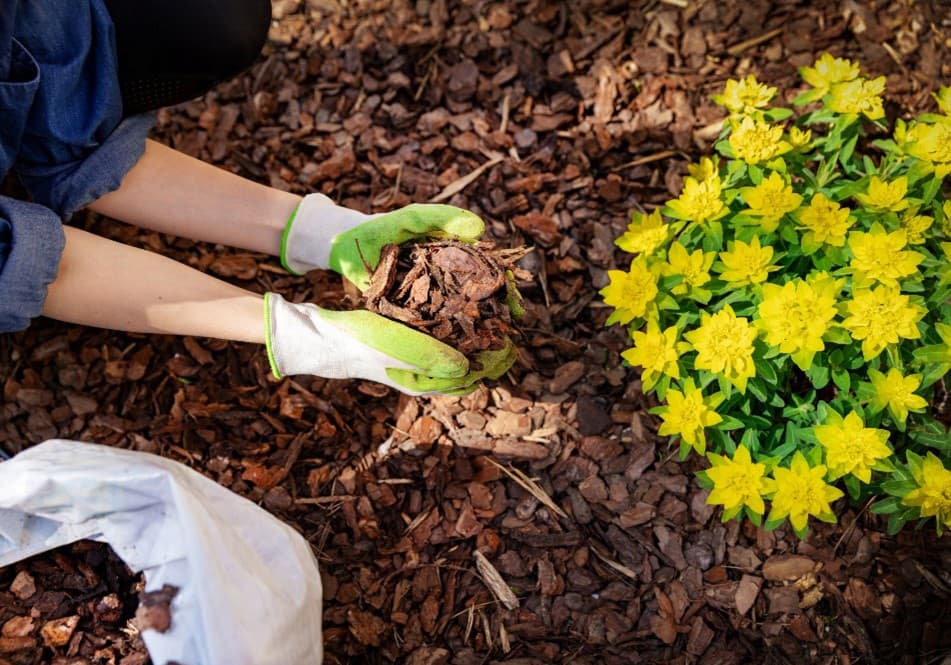
Every year in spring add a 5cm layer of composted organic matter to the surface of your soil as a mulch. You do not need to dig it in. The organisms living in the soil will pull it down for you. Digging soil that is not compacted damages the structure of the soil. It also releases carbon dioxide into the air, which is better locked up in the soil. Digging is time-consuming and hard work, have a cup of tea instead and relax. If you can’t manage mulching a 5 cm layer over the whole area every year, it is better to add a 5 cm layer to a smaller space. The following year mulch a different part of the garden. Alternating areas with a thicker mulch is better than spreading more thinly every year.
Mulching does more than improve the nutrition in the soil and improve its structure. It also acts like a blanket, warming it up in spring a little earlier. It suppresses weeds giving you more time to do other things. It reduces the evaporation of water from the soil surface in dry weather, so your soil doesn’t dry out so quickly. You can use gravels and stone chippings as mulches and they will work to keep weeds down and retain moisture but as it is necessary to replenish nutrients in the soil regularly it is a good idea to use organic mulches. Mulching is magic!
A word about animal manure – only use manures from herbivorous animals to make compost, not those from carnivores. So no cat or dog faeces but yes to chicken, cow and horse manure. The bedding from small furry pets like rabbits or hamsters can be composted but make sure it is damp before adding to the heap. Compost made from these items is rich in nutrients and will improve soil structure when applied to garden soil. Manures should only be applied when they are well-rotted. Fresh manure is too strong and can burn plants and may harbour pathogens harmful to humans. Before using horse manure check it hasn’t come from animals that have eaten grass treated with aminopyralid or clopyralid based weedkiller. These chemicals can persist and kill your plants even if the manure has rotted down.
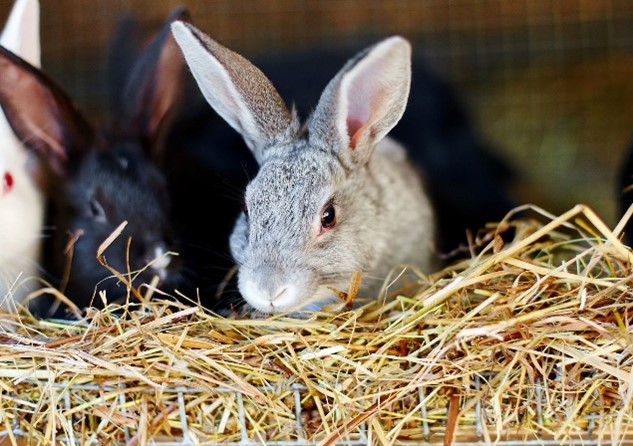
4. Rotate Vegetable Crops Each Year
Home grown produce is fantastic. It tastes great, has zero food miles and is cheaper than buying from a supermarket. But, constantly growing and harvesting crops from the same piece of ground can deplete the goodness in the soil and allow pests and diseases to build up in one place.
Follow the yearly ritual of mulching the surface but switch between manure and compost depending on the crop you are planning to grow next. Courgettes, pumpkins and beans, for example are greedy, and like manure added ahead of planting. Whereas too much goodness makes carrots and parsnips fork, so they prefer compost.
If you manure the soil and grow courgettes one year follow that with compost and carrots the following year. The roots of peas and beans contain nodules which increase the nitrogen in the soil. Follow them with leafy crops, like salads which will like the extra nitrogen.
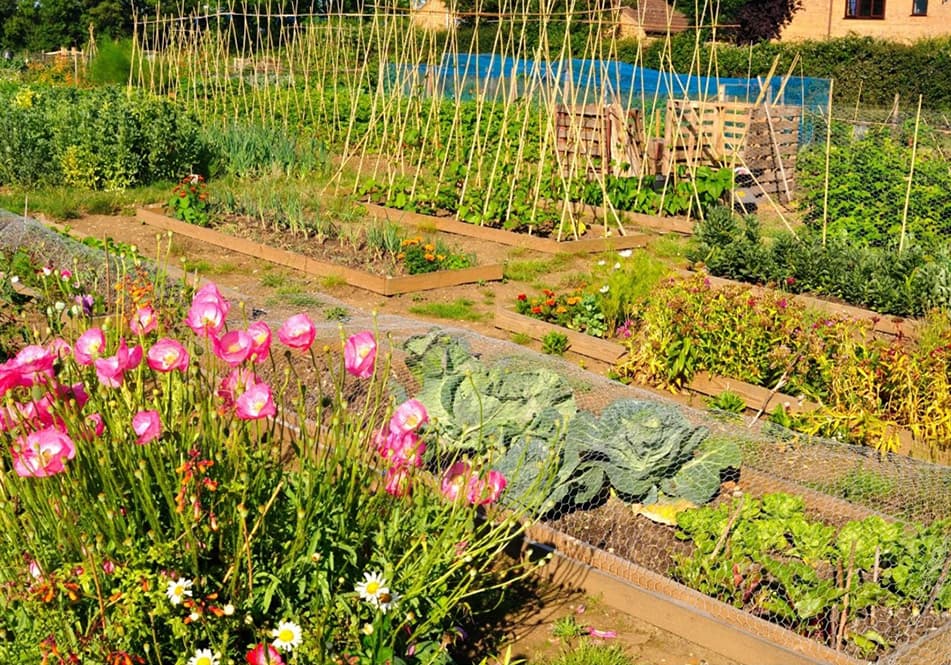
Changing where you grow crops can also prevent pests and diseases building up in one place. Follow the three-year rule; rotate crops each year so that the same family of vegetables is not grown in the same place for at least three years or more. That gives enough time for most soil pathogens to die.
5. Don’t Leave Soil Bare
Bare soil is easily eroded by heavy rain and winds. It also allows nutrients to be washed out and soil becomes compacted. Weeds will quickly move in, increasing your work load. In a vegetable bed, grow a cover crop to prevent this. Cover crops for vegetable beds are known as green manures. They should be chopped down and dug in before they set seed. The plant material will decay, improving soil fertility whilst suppressing weeds. Some plants also add to soil health, lupins, peas and nasturtiums for example add nitrogen to soil.
In a flower bed try not to leave big gaps between plants. In spring fill gaps in borders with annuals if you are waiting for newer shrubs and perennials to fill out to their full size.

If you have cleared a crop in an allotment or vegetable bed in autumn and you don’t need the space again until spring, cover it with a layer of wet cardboard or newspaper. Top that with 5 cm of compost or rotted manure. Open out any empty compost bags and lay them over the bed. Weigh the bags down with rocks or bricks or something similar. When you are ready to plant out the following season, the beds will be weed free and ready to plant straight into. Store the bags for reuse next year.
Soil is made up of minerals, water, organic matter, micro-organisms, and mini-beasts, which all play a vital role in the growth of plants. Testing the pH of the soil is the first step in understanding the nutrients available in your soil. Soil can become compacted over time, making it hard for plants to put down roots and access nutrients. Digging to release the compaction and adding organic matter is necessary. After that mulching is the most effective way to improve the nutrition and structure of the soil, suppress weeds, and reduce evaporation. Healthy soil leads to healthy plants. Healthy plants are less likely to succumb to pests or diseases. By following these guidelines you will help to build the fertility and health of your soil, leading to abundant harvests and happy beautiful plants.

By our resident horticultural expert





